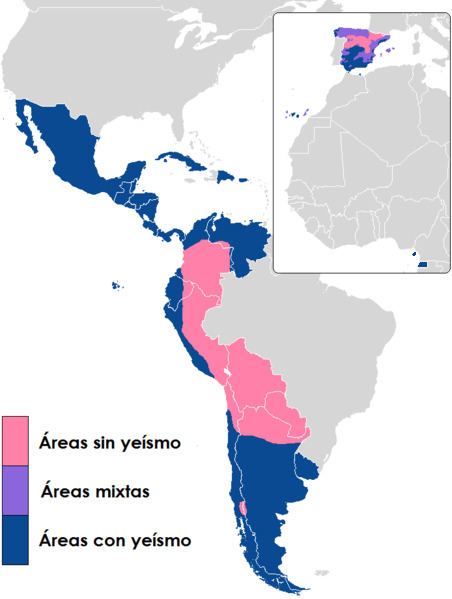 | ||
Yeísmo ([ɟʝeˈizmo]) is a distinctive feature of many dialects of the Spanish language, which consists of the loss of the traditional palatal lateral approximant phoneme /ʎ/ (written ⟨ll⟩) and its merger into the phoneme /ʝ/ (written ⟨y⟩), usually realized as a palatal approximant or affricate. It is an example of delateralization.
Contents
In other words, ⟨ll⟩ and ⟨y⟩ represent the same sound /ʝ/. The term yeísmo comes from the Spanish name of the letter ⟨y⟩ (ye). Now, over 90% of Spanish dialects exhibit this phonemic merger. Similar mergers exist in other languages, such as Italian, Hungarian, Catalan, Portuguese or Galician, with different social considerations.
Occasionally, the term lleísmo (pronounced: [ʎeˈizmo]) has been used to refer to the maintenance of the phonemic distinction between /ʝ/ (spelled "y") and /ʎ/ (spelled "ll").
Pronunciation
Most dialects that merge the two sounds represented by ⟨ll⟩ and ⟨y⟩ realize the remaining sound as a voiced palatal fricative [ʝ], which is similar to the ⟨y⟩ in English your, but it sometimes sounds like ⟨j⟩ in English jar, especially after /n/ or /l/ or at the beginning of a word. For example, relleno is pronounced [reˈʝeno] and conllevar is pronounced [koɲɟ͡ʝeˈβaɾ] or [koɲdʒeˈβaɾ].
Zheísmo
In most of Argentina and Uruguay, the merged sound is pronounced as a sibilant [ʒ]; this is referred to as zheísmo. In Buenos Aires, the sound [ʒ] has recently been devoiced to [ʃ] (sheísmo) among younger speakers.
Note that the same shift from [ʎ] to [ʒ] to [ʃ] (to modern [x]) historically occurred in the development of Old Spanish; this accounts for such pairings as Spanish mujer vs Portuguese mulher, ojo vs olho, hija vs filha and so on.
Extent of yeísmo and lleísmo
Yeísmo has always been common in much of Latin America, mainly in lowlands, and in large areas in Spain.
The distinction between /ʝ/ and /ʎ/ remains in the Philippines, Ecuadoran highlands, Andean Peru, Paraguay, Bolivia, and the northeastern portions of Argentina that border with Paraguay. The distinction is more common in areas with a common bilingualism with indigenous languages, such as Aymara, Quechua, and Guaraní. In Spain, most of the northern half of the country and several areas in the south used to retain the distinction, but yeísmo has spread throughout the country, and the distinction is now lost in most of Spain, particularly outside areas with linguistic contact with Catalan and Basque.
Minimal pairs
Yeísmo produces homophony in a number of cases. For example, the following word pairs sound the same to speakers of dialects with yeísmo, but they would be minimal pairs in regions with lleísmo:
The relatively low frequency of both /ʝ/ and /ʎ/ makes confusion unlikely. However, orthographic mistakes are common (for example, writing llendo instead of yendo). A similar effect took place in the local name of the island of Majorca: Mallorca is a continental Catalan hypercorrection of the earlier Maiorca.
Other languages
Similar phenomena occurred in other languages.
